Film
Today we open the door to the film. Before you start you have to say that they are explanations based on the black and white film. From them, it will certainly be easier to understand the peculiarities of the colored.
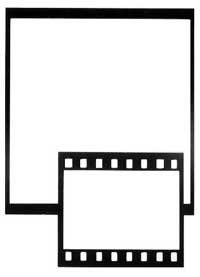
When we talked about camera, we saw that there were cameras of different formats. Also, the films are of different formats that adapt to each type of camera. In addition, the film can have different supports: page, roll, chassis or cartridges.
The type of film that has been used most in photography is a film wrapped in a 6 cm medium width roll. Today, advances in optics and emulsions have expanded small formats (35 mm. or less) and have limited the average formats (6 cm. to professionals.
Most cameras, both reflex and direct viewfinder, use a 35 mm film on chassis.
The size of the field that this film has for each image is 24x36 mm, while the 35 mm that name the film take diagonals. Although the most common is the acquisition of reels already prepared in chassis for a certain number of photographs or exhibitions, there is also the possibility of acquiring boats that include a film of 15 m or more for the preparation of each of the works in sight.
After the format, sensitivity or “speed” is the next point to consider when choosing the film. Sensitivity indicates how quickly the film reacts to light. This is expressed in the grades ISO (International Standardization Organization) /ASA (American Standards Association) or DIN (Deutsche Industrie Norm).
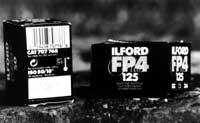
ASA, has been replaced by ISO, which use the same numbering system. In Europe, the DIN scale is mostly used, but most films have both. As the ISO number increases, speed also increases. The 400 ISO film, for example, has a sensitivity twice as high as 200 ISO, so doubling the sensitivity also doubles the speed.
The faster the film, the lower the exposure and the larger or smaller the image size. This is because, to increase sensitivity, the emulsion is made with a larger silver clump and observed in the enlargements.
The choice of sensitivity should take into account the lighting conditions and the subjects to be photographed.
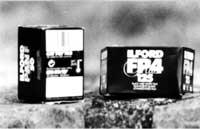
Depending on their sensitivity, the films are divided into four groups:
Slow movies: Less than 64 ISO
Its low sensitivity is limited by two factors: on the one hand, by the composition of small clumps of halide and on the other, by the presence of a thin layer of emulsion.
Being a very small or thin film, images of great detail are obtained. Suitable for use in obtaining large quality enlargements and without lumps. Due to its slowness, we must not forget that this type of film needs more light than the rest to achieve a correct exposure. For the same reason, high exposures and openings are required, with reduced depth of field and sketched moving elements.
Medium films: Between 65 and 160 ISO

These also have a small hail. They have less contrast than slow ones and are of great latitude. They can be used in most normal situations. They are suitable for working outdoors and in well-lit interiors. When used outdoors, due to strong light, they offer a wide variety of combinations of openings and speeds (otherwise, you have to resort to long exposures and large openings). Extensions can be made from negatives of 35 mm up to 18x24 cm without losing detail.
Fast Movies: Between 160 and 800 ISO
Vikorra more visible (especially when 35 mm negatives produce ampliations greater than 18x24 cm). They allow work in any situation (except when the light is too large or almost in absolute darkness). Less contrast than the previous ones. They are suitable for cases where large expansions and details are not needed, and for low or unknown light levels. This material is usually used when high shutter speeds are needed to slow movement.
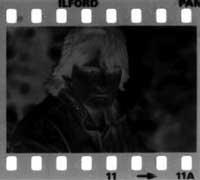
Even when a large depth of field is desired, these allow working with small diaphragms
Ultra-fast films over 800 ISO
They have a thick granulate (thick emulsion and high content in halides) and are of low definition. They are suitable for the use of very poor light (dark, night, etc.) or high shutter speeds.
Everyone has to do with what situation they should work in and what results they want to achieve. However, the best is the same brand and sensitivity (in the order of 125 or 400 ISO e.g.) is getting used to using it and changing it only when you want to get a special result, since it is the way to get the maximum performance of the film (this is not achieved from the beginning, but by the use).
Exposure (amount of light coming into the film) is controlled by opening and speed. Proper exposure requires knowing the sensitivity of the film to the light and clarity of the subject. We talked about the first in these lines and the second in the next section.
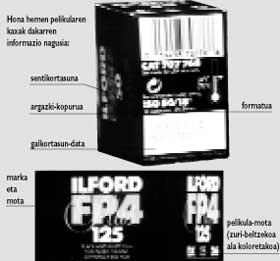
Black and white films The black and white film is composed of light-sensitive silver halides (bromuros, iodide or cluoruros). Silver halides form an emulsion suspended in gelatin. The emulsion is placed on the base of cellulose triacetate, placing on the other side an anti-halose layer. That is the structure of the film. These silver halides are broken down by light effect and begin to form black metallic silver granites. The light does not have sufficient capacity to carry out the process and although the image has been collected it is not visible. The vision of the image or, what is the same, the complete formation of black silver is achieved through the development. The film is tanned with different intensity in the development, depending on the light that has come from the subject. In this way a series of tones is formed. Being the black silver you get the negative of the image. The positive is done on a paper formed by emulsions similar to those of the film. |
Tips Films should be kept before and after use. For this purpose:
|
Buletina
Bidali zure helbide elektronikoa eta jaso asteroko buletina zure sarrera-ontzian











